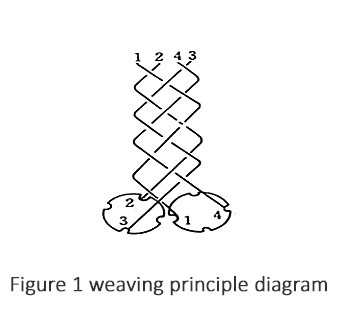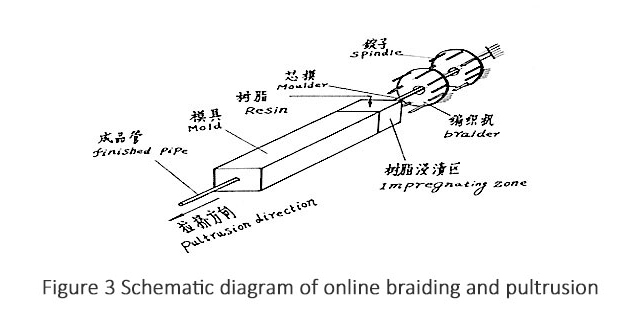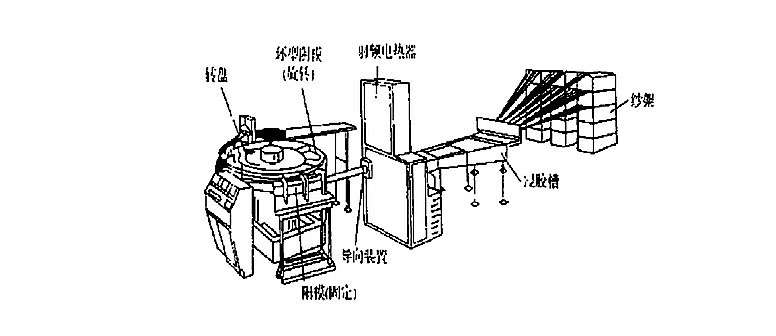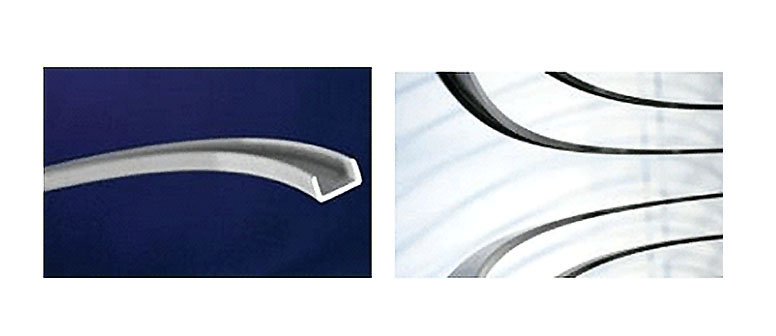Present situation and latest technological progress of Pultrusion
Pultrusion process is still in the high-speed development stage. From the domestic and foreign development trend, mainly for the production of large size and complex surface, I hope the product, focusing on the development of new marine composite materials, power transmission, civil engineering structure, and high-rise building project. At present most thick pultruded products has reached 101.6mm, while the pultrusion process from the mold cavity "black art" to the experimental means more scientific, repeated verification study on curing kinetics of mold, at the same time by means of a variety of electronic equipment, resin injection mould design and optimize quality, improve productivity, with the development of the advanced the equipment, process that had previously been considered unthinkable will continue to emerge.
Pultrusion process is still in the high-speed development stage. From the domestic and foreign development trend, mainly for the production of large size and complex surface, I hope the product, focusing on the development of new marine composite materials, power transmission, civil engineering structure, and high-rise building project. At present most thick pultruded products has reached 101.6mm, while the pultrusion process from the mold cavity "black art" to the experimental means more scientific, repeated verification study on curing kinetics of mold, at the same time by means of a variety of electronic equipment, resin injection mould design and optimize quality, improve productivity, with the development of the advanced the equipment, process that had previously been considered unthinkable will continue to emerge.
On-line braiding and pultrusion
At the beginning of twentieth Century on the realization of automatic woven composites, the traditional weaving is uniform in core shaft orbit in braiding machine movement to achieve the woven preform can be impregnated by hand paste or automatic injection technology or directly adding resin in knit molding. In theory, compared with other preform manufacturing technology, the most suitable for woven tubular parts pultrusion, the biggest advantage is able to weave into the unidirectional fiber braided structure, axial fiber woven fabric can be from any point introduction. The structure is an organically stable combination of the continuous circumferential reinforcement and the axial reinforcement.
All fibers of the fabric are obliquely crossed and the angle between the axis and the axis is 0 and 90 degrees. The weaving principle and the weaving tube are shown in Figures 1 and 2. In the course of knitting, the movement track of fiber is spiral. Reasonable fiber angle can be used to adjust the ratio of radial strength and axial strength of the product tube. At the same time, proper fiber arrangement density can be chosen to meet the requirements of strength and appearance.
Figure 1 Knitting principle diagram

Figure 2 Braided casing

As for technology, knitting machine ready for local transformation, the original machine on the coiling part crank, worm gear, etc. removed via volume. The mandrel is changed into the core mold of the corresponding diameter. The core die extends into the mold, forming the inner diameter of the product, and the size accuracy and smoothness of the core die are higher. The shaft should be fixed firmly, and can be adjusted in 4 directions, up, down, left and right.

Figure 3 is a schematic drawing of an on-line extrusion drawing. The end of the mandrel self sewing machine passes through the mold. The resin is impregnated with the fiber through the pump and injected into the cavity at the front end of the mold under pressure.
The coil tube fiber woven by pultrusion machine index traction apparatus, mandrel fixed, fiber woven along the mandrel, into the mold, impregnated with resin impregnated resin in the mold entrance area, the traction by heating the mold in the mold, gel, curing, eventually became FRP pipe products. At present, domestic manufacturers have adopted this process to put into production, and declared patent.
Polyurethane pultrusion
The traditional pultrusion resin for polyester, vinyl ester and epoxy resin, pultrusion is for the current development of new technology using polyurethane resin, Bayer Material Sciences Corp is to vigorously promote the development of this technology, and has successfully produced polyurethane pultruded products listed.
The new two-component polyurethane is patented to blend polyols with a highly reactive isocyanate. Isocyanate added with the following characteristics: low viscosity (good impregnated fiber), gel time (temporary shutdown, easy polymerization) (rapidly improve the forming speed), good surface finish, cost competitive. Compared with other materials, the advantages of polyurethane pultrusion are obvious. The utility model can improve the content of the glass fiber in the product and greatly improve the strength of the product. For example, pultruded window frames made of glass fiber and polyurethane resin, the strength of the resulting window frames is 8 times higher than that of the PVC window frames, and the conductivity is 40 times lower than that of aluminum. Therefore, the insulation performance is much better. At the same time, because polyurethane pultruded window frames are less brittle, they won't crack and will last longer.
Polyurethane pultrusion technology has the following advantages:
1、With the traditional resin pultrusion of certain shapes, may require the use of as many as 4 or 5 different kinds of glass fiber mat, using polyurethane pultrusion, often with fiberglass roving instead of glass fiber mat, mat easily broken, debris may plug the machine production. After the glass fiber mat is removed, the material cost and labor cost of the felt are reduced. After removing the felt, the production line speed can be increased to a certain extent, thereby increasing cost effectiveness. On the other hand, with the roving felt instead of fiber volume content, can increase to about 80%, and the majority of non fiber polyurethane pultruded products was 60%. In this way, higher glass fiber content is combined with better resin to create a polyurethane pultrusion section with better strength and stiffness.
2、Polyurethane pultrusion products are more widely used. These products can be used for polyester resins, not for the purpose of construction, infrastructure and transportation market, instead of steel and aluminum.
3、The transition from the original pultrusion system to the polyurethane pultrusion system is simple, convenient and economical without large investment. The original die, heater and unit can still be used. There are two types of equipment to be retrofitted: resin metering / mixer and resin injection box. First, since polyurethane is a two-component system, a special metering / mixing device is required. Second, because of the reactivity of polyurethane resins, the traditional open resin tanks need to be removed and replaced by resin injection systems to accommodate the faster gelling time of polyurethanes. Bayer Material Sciences Corp designed a resin injection box to optimize the impregnation of glass fibers during pultrusion. The injection box can be made of high-density polyethylene material to reduce costs, facilitate cleaning and prevent fiber damage. The pumping speed of the two components of the resin is matched with the resin consumption rate and sufficient pressure is maintained in the injection chamber to ensure penetration of the glass fiber.
4、The polyurethane pultrusion parts also have the advantages of assembly, especially the fastening. When polyurethane screws are packed with screws, they do not need to be drilled in advance, thus saving time and labor. In turn, the force required to pull out the screws in a polyurethane pultrusion product is two times greater than the strength required to pull the screws out of the polyester pultrusion product.
CRTM(Reaction injection pultrusion)
Reaction injection molding is developed in the late 1970s, the glass fiber yarn guide and pre molding, into a continuous resin transfer molding mold, the mold to stable pressure and flow into the special resin and the glass fiber is fully soaked and eliminates the bubble into the mold, curing in the traction machine, so as to realize the continuous resin transfer molding (Continuous Resin TransferMolding Pulltrusion Process CRTM) or injection pultrusion. This method is not used in polymer materials, it will be two or more than two kinds of liquid monomer or prepolymer, with a certain proportion were added to the mixture in the mixing head, under pressure, immediately injected into the closed mold, curing in mold, forming products, because the raw material is of low viscosity liquid with less pressure, which can quickly fill the die cavity, thus reducing the clamping force and mould cost, especially suitable for the production of large area products. The reaction injection molding requires that each component be mixed and react immediately and the material can be cured to the degree that it can be removed. Therefore, special materials and formulations are used, and sometimes products need to be treated with heat to improve their performance. The key of forming equipment is the structure design of mixing head, accurate measurement and transportation of each component. In addition, the temperature control of raw material storage tank and mold is also very important.
Reaction injection pultrusion has the following advantages:
1、The glass fiber is fully soaked, and the FRP products have less micro bubbles and excellent mechanical and electrical properties;
2、The resin supply system is easy to isolate from the atmosphere, and the performance of the product is not affected by the environment;
3、The injection of the resin has always maintained the same curing characteristics (has been "new gum");
4、Easy to obtain transparent products, products defects (such as inclusions, yarn, etc.) easy to find and delete;
5、Little impact on the environment and the operators.
Curved surface extrusion
Based on the existing pultrusion technology, Goldworthy Engineering has developed a pultrusion process which can be used to produce curved surface profiles. It is used to produce spring leaf for automobiles. The technology of the pultrusion equipment by the fiber guiding device (for distribution fiber) and dipping tank, RF power device preheater, guiding device, rotary plate, fixed die mold mold base, mold heater, high-speed cutter etc.. The raw materials used are unsaturated polyester resin, vinyl resin or epoxy resin and glass fiber, carbon fiber or hybrid fiber. The production process for the spring bow: fixed in the rotating platform, die with the same curvature of the concave spring (called rotary die), to form a complete ring mold, the number of female die should be matched with the length of leaf spring.
At the same time, the fixed mold mold base concave, convex surface and rotating ring die corresponding to the gap between them is forming mold cavity. The turntable rotates, traction with resin impregnated material enhancement after high-frequency preheater and yarn guide device, closed cavity fixed mode by close to the end of the yarn guide device is composed of a fixed template into the mold and rotating die, then according to the shape of the mold forming, bending structure. The product is always placed in the mold cavity before being cut. When the product after cutting is removed from the die cavity, the rotating die is introduced into the next production position.

The German Thomas company has recently developed a new manufacturing technology, "radius pultrusion", which makes it possible to produce continuously curved pultruded profiles at almost any radius of view. The technique produces an arched or circular part, including a spiral section, that allows us to jump out of one dimension and produce three-dimensional pultruded profiles Radius pultrusion can be applied to automobiles, aircraft, structures, buildings and furniture, and allows bending and continuous profile projects.

In recent years, the pultrusion process has achieved rapid development, which is closely related to the adoption of new resins and the application of new forming technology, and greatly expanded the applicable areas of materials. At the same time, the new sensor and control technology, but also further enhance the quality of pultruded products, the production process of FRP pultrusion which has a strong vitality will become the main production technology and many new products in the future.


